Into the heart of Saradiel country
View(s):Utuwankande is where the legendary Saradiel roamed and for photographer Stefan D’Silva this rocky hideout is one of those forgotten places which he feels must be documented before it falls under the tide of modernisation. Though based in Australia, Stefan has a strong passion for his roots and is currently in the process of compiling a series of books about Sri Lanka; the third of which, ‘Places Once Denied’, was launched a few months ago.
When he’s not jetting back and forth from Down Under, Stefan can be found trekking to places off the beaten track like Utuwankande, attempting to capture their magic before it disappears. Here is his account of his journey up Saradiel’s rock.
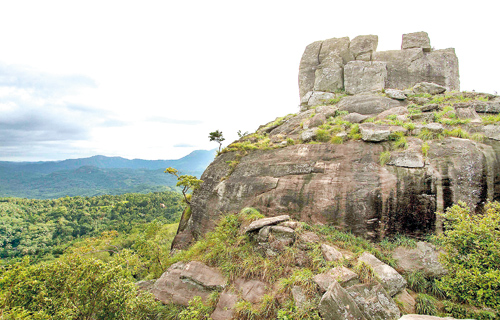
At the top. The unusual formation on the top of the rock is the ‘peak’ of Utuwankande
A closer glimpse of the rock hideout: This mysterious landmark on the Colombo- Kandy road has been driven past by many people over the years and the legend of Saradiel was likely to have been related to many a child by their parents as they drove past. Often referred to as the Robin Hood of Sri Lanka the legend of Saradiel is still retold.
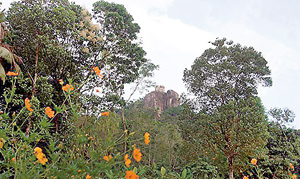
The Saradiel Village and Theme Park in the valley below sets the era for the legend of Saradiel.The stone coach indicates 1832. The coach is identified as the Colombo- Kandy Royal Mail coach. Reputedly one type of transportation targeted by Saradiel.
The Palanquin (below) depicts the mode of travel by some of the privileged class of people who may have also been robbed by Saradiel. The attention to detail is precise in terms of dress, palanquin design and style of the era.

Saradiel was born on 25th March 1832 to Adissi Appu and his wife Pichohamy close to Utuwankande. According to local legend he earned the comparison to Robin Hood from the British after he stole the sum of £8 from a British official. The story goes that Saradiel took the exact amount of £8 even though the official had £125 with him. The sum taken by Saradiel was the exact amount required to repay a debt he owed.
Rural scenes at the foot of Utuwankande:
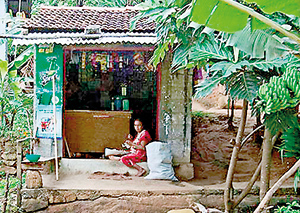
A small “kade”. A woman busies herself with some chore as she watches us walk past. Probably wondering what all the fuss is about climbing the hill in her ‘front yard’.
On the way up: A leaning slab of rock that provided some shelter from the rain, on the way back some hours later.
All written material on Saradiel states he was of slim build and small in physical stature. However, it is also clear that he made up for the lack of a large physique with a fiery and fearless temperament.
After a fight at the IIlukgoda Temple School, where he was blamed for assaulting a rich boy, Saradiel took his chances in Colombo and got a job as a ‘batman’ for a British Army officer with the Ceylon Rifles Regiment in Slave Island. It is thought he familiarised himself with weapons during that phase of his life.
The job did not last long and he stole the officer’s silverware, together with some arms and fled Colombo. He returned to Molligoda, gathered a small gang of local ruffians and made the rocks and caves of Utuwankande his stronghold. Life as a bandit and highwayman had begun.
Utuwankande provided this band of highwaymen a commanding view of the Colombo – Kandy road.
The peak in the distance is the north face of Bible Rock – quite a different view of Bible Rock from what most people are accustomed to as they drive up the Kadugannawa Pass.
Getting closer to the top
A very different view of Bible Rock (northern face) from the top of Utuwankande. Bible Rock too is one of those landmarks that was pointed out or gazed upon, as a far off mysterious place, by many people as they took the climb by car on the Kadugannawa Pass, en-route to Kandy.
Mawanella town from the top: One can easily comprehend the commanding view that Saradiel and his band of outlaws had as they surveyed the Colombo- Kandy road below. Given that the transport of the era was by horse drawn coach or bullock cart it would have given the highway robbers plenty of time to descend the hill and ambush the targeted travellers.
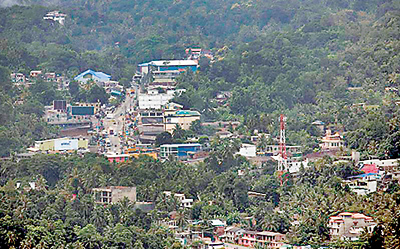
One of the rock shelters on top: One can imagine the fugitive Saradiel sheltering amongst these rocks in the times gone by.
One of the large rock overhangs/shelters half way to the top. To explore this rock overhang and examine one of the legendary caves connected to the exploits of Saradiel one has to scramble up a small rock face with the aid of vines/creepers ‘flowing’ over it. Nevertheless, the effort was worth it if only to get some ‘feel’ the paths trod by the highway robbers over a hundred years ago.
I like to think that Saradiel made some use of a small cave (not seen here) on the rock face –perhaps to store food or other items that needed sheltering/protection from the weather.
The cave on the right under this particular rock overhang. which is reputedly one of the caves that enabled Saradiel to make good his escape in times of pursuit.
According to one local legend it was the escape route Saradiel chose when pursued by the authorities–the cave is thought to lead to the other side of the mountain. Legend states that Saradiel took this route and when he emerged on the other side he leaped over the narrow gorge of the Maha Oya river close by, injuring his left arm/elbow.
He carried that injury to his execution and that injury is depicted in the statues illustrating his execution at the Saradiel Theme Park.
An interesting scene: The stone statues depicting the captured Saradiel and his co- accused Marikar, (a member of Saradiel’s gang) under escort. The statues set the scene in relation to the transport and uniforms of the era. Quite symbolic that this scene is under the shadow of the outlaw’s stronghold. The statues’ attention to detail show the broken left elbow of Saradiel.
Saradiel and Marrikar were hanged together at Gallows Hill, Kandy before a large crowd on 7th May 1834. Saradiel was 32 years of age and died a converted Catholic.
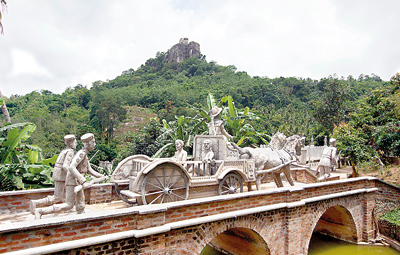
A memorial just outside Mawanella Town: The memorial commemorates Constable Sabhan who was shot dead by Marikar in the final capture of Saradiel and Marikar. The other names on the monument are also police constables killed in a previous attempt to capture Saradiel.
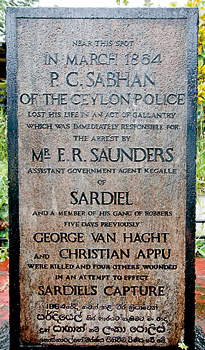
comments powered by Disqus


